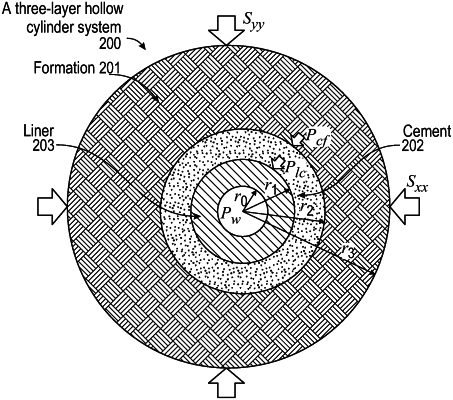| CPC G01V 99/005 (2013.01) [E21B 47/005 (2020.05); E21B 47/007 (2020.05); E21B 49/00 (2013.01); E21B 2200/20 (2020.05)] | 19 Claims |

|
1. A method for evaluating an integrity of a liner disposed in a wellbore that contacts a formation through a cement layer between the liner and the formation, the method comprising:
obtaining geometric data and at least one property of the liner using at least one of a sonic measurement, a seismic measurement, a density log and a rock mechanics testing;
determining, by a computer processor, in-situ stress and pore pressure on the formation;
computing, by the computer processor, a stress on a boundary of the liner by an iteration procedure that implements an analytical solution of stresses on a liner-cement interface and a cement-formation interface using the geometric data, the at least one property, mean in-situ stress and the wellbore pressure;
constructing, by the computer processor, a computational numerical model for simulating interactions between the liner, the cement layer and the formation;
performing, by the computer processor, a plurality of numerical simulations using the computational numerical model to calculate a magnitude and distribution of stress acting on the liner-cement interface and the cement-formation interface, wherein the plurality of numerical simulations are repeatedly performed to obtain model-predicted stresses;
comparing, by the computer processor, the model-predicted stresses on the liner-cement and cement-formation interfaces with values provided by the analytical solution until the model-predicted stresses substantially match the analytical solution; and
performing, by the computer processor, the plurality of numerical simulations using actual in-situ stresses to replace the mean in-situ stress on an outer boundary of the formation layer to calculate the magnitude and distribution of stress acting on the liner-cement and cement-formation interfaces using a calibrated computational mesh where the analytical solution and numerical simulation results match;
applying, by the computer processor, the calculated stresses acting on the liner to a liner integrity evaluation model to determine the integrity of the liner at a plurality of stages of the wellbore;
determining, by the computer processor, a type of second liner based on the liner integrity evaluation model; and
performing a production operation using the wellbore and based on the type of second liner.
|